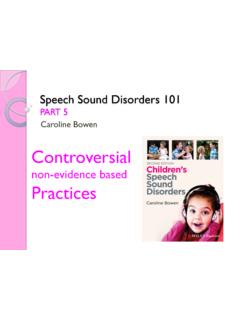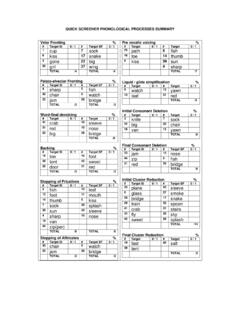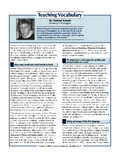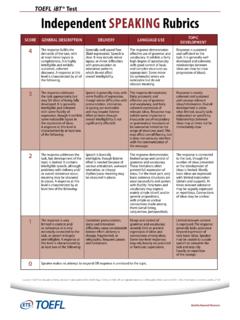Transcription of A core vocabulary approach for management of inconsistent ...
1 A core vocabulary approach for management of inconsistentspeech disorderBARBARA DODD1,2, ALISON HOLM1,2, SHARON CROSBIE1,2, & BETH MCINTOSH1,21 Perinatal Research Centre, University of Queensland and2 Royal Brisbane and Women s Hospital,Queensland, AustraliaAbstractDevelopmental speech disorder is accounted for by theories derived from psychology, psycholinguistics, linguistics andmedicine, with researchers developing assessment protocols that reflect their theoretical perspective. How theory and dataanalyses lead to different therapy approaches, however, is sometimes unclear. Here, we present a case management plan for a7 year old boy with unintelligible speech. Assessment data were analysed to address seven case management questionsregarding need for intervention, service delivery, differential diagnosis, intervention goals, generalization of therapeuticgains, discharge criteria and evaluation of efficacy.
2 Jarrod was diagnosed as having inconsistent speech disorder that requiredintervention. He pronounced 88% of words differently when asked to name each word in the 25 word inconsistency test oftheDiagnostic Evaluation of Articulation and Phonologythree times, each trial separated by another activity. Other standardizedassessments supported the diagnosis of inconsistent speech disorder that, according to previous research, is associated with adeficit in phonological assembly. core vocabulary intervention was chosen as the most appropriate therapy technique. Itsnature and a possible protocol for implementation is : inconsistent speech errors, intervention, phonological child referred with unintelligible speech isunique. Clinicians consider the characteristics of thechild s speech errors, other language abilities, thefamily, educational context, medical and socialhistory.
3 This information is used to deduce causaland maintaining factors of the disorder and deter-mine whether therapy is indicated. If therapy isoffered, clinicians make a series of decisions aboutdiagnosis, setting goals for the child and carers,planning how to implement intervention and moni-tor its effectiveness. Here we present a clinicalmanagement plan for Jarrod, a 7 year old boy withunintelligible management approach is based on a clinicalproblem solving model (Whitworth, Franklin, &Dodd, 2004) developed for speech-language pathol-ogy undergraduates that poses seven questions (seeTable I). There is no one right answer for anyquestion. Rather, the questions elicit systematicconsideration of evidence from the child s data inthe context of each clinician s evidence base thatincludes knowledge of theory and research, clinicalexperience and the constraints of the governingspeech-language pathology service.
4 Experiencedclinicians make decisions without reference to aformal schema, but here we use it to make ourclinical management paper answers seven clinical managementquestions about Jarrod, a 7 year old boy who wasassessed by Holm & Crosbie (2006). He wasidentified by an Education Queensland speech-language pathologist working in Brisbane, Australiaand consent obtained. Jarrod s speech and languagewas assessed to provide data for a special issue ofAdvances in Speech-Language Pathologydevoted tothe topic of intervention for a child with phonolo-gical impairment. Individual assessment byunfamiliar, experienced paediatric speech-languagepathologists was conducted at school in a quietenvironment in three 75-minute sessions, withbreaks between tasks. The assessments were videoand audio recorded for transcription and was compliant with assessment demands,initiated conversation and responded well toencouragement.
5 Standardized test results werecommunicated to Jarrod s parent, teacher andspeech-language pathologist. Jarrod s data areCorrespondence: Barbara Dodd, PhD, Level 6 Ned Hanlon Building, Royal Brisbane and Women s Hospital, Herston, QLD 4029, : 61 7 3636 4011. Fax: 61 7 3636 1769. E-mail: in Speech Language Pathology, September 2006; 8(3): 220 230 ISSN 1441-7049 print/ISSN 1742-9528 online The Speech Pathology Association of Australia LimitedPublished by Taylor & FrancisDOI: in other papers in this volume and ratherthan summarize that information we include it tojustify our answers to the seven clinical manage-ment intervention indicated?Olswang and Bain (1991, p. 255) recommend thatthe decision to offer intervention ( focused,intensive stimulation designed to alter specificbehaviours ) should be based on whether a parti-cular linguistic skill matches other abilities; and,whether there is potential for change.
6 Other factorsinvolve carer, teacher and child concern and theeffects of the communication difficulty on social andacademic development. Another issue is the practi-calities of intervention irrespective of the degree ofdisability. The advantages of attending therapy mustoutweigh the difficulties of s speech difficulty warrants intervention forthe following reasons:(i) His profile of ability was uneven when he wasassessed by standardized measures. Jarrod sspeech was unintelligible, even to his motherwhen out of context, but his languageperformance was within the normal rangeon all subtests except expressive verbal IQ scores have also been consis-tently poorer than his performance IQ.(ii) Jarrod expressed concern about his unin-telligibility and playing alone.
7 His motherhas sought speech-language pathology inter-vention and recognized his current need forfurther intervention. His teacher s concernwas demonstrated by her referral of Jarrod tospeech-language pathology.(iii) Jarrod s grandparents noted an inconsistentbehaviour profile. There were times when hedoes not comply with instructions, lacks eyecontact, and has a short attention span. Thepsychologist s report noted; however, thatJarrod could be brought back to task andanswered questions readily. He was reportedto concentrate for long periods on activitiesthat interest him. His teacher reported poorsocial skills although his mother expressedno concern. These inconsistencies mayindicate that Jarrod s speech difficulties areaffecting his social and learning s potential for change may be limited,however, since little progress has been noted overthe past 3 years despite several episodes of interven-tion from different speech-language pathologists anda year in special educational is the client s diagnosis?
8 Assessment data allow differential diagnosis of theaspects of the communication system that aredisordered, establishing linguistic patterns, severity,and possible causal and maintenance factors. Plan-ning individualized client management is depen-dent upon identification of the deficit(s) in thespeech processing chain that underlie the speechdisorder since that knowledge governs the choiceof skills ( oro-motor, auditory discrimination)or language units ( sentences, phrases, words,syllables, phonemes, phones) that should be targetedTable I. A series of clinical management questions and data from Child and FamilySpeech-Language Pathology Service Policy1. Is intervention indicated?Child and carer concernService policyDiagnosis, ability profilePrioritizationPracticality of attending therapyIntervention evidence base2.
9 What is the client s diagnosis?Assessment of articulation, phonology, oro-motor skills, language, cognitionService protocols3. What service delivery model should be chosen?DiagnosisService constraintsPracticality of attending therapyCarer and child preference4. What are the goals of intervention?- Ultimate (prognosis)- Long term (episode of intervention)- Short term (session plans)Diagnosis, cognition, severity, case history, assessment data, service delivery chosenService constraints5. How will generalization be aided?Carer/school capacity for involvementMultidisciplinary workingService delivery chosen6. What discharge criteria?Carer/child opinion; prognosis; progressService policy7. How will efficacy be assessed?Clinician knowledge baseService auditingCore vocabulary for inconsistency221in therapy.
10 The speech processing chain is oftenpresented as a model of the mental processes involvedin the sensation, perception, representation, phono-logical planning (of word shape), phonetic planning(of speech sound production) and motor execution ofspeech ( Dodd & McCormack, 1995). Here weconsidered Jarrod s assessment data under specificheadings (mental abilities implicated in the speechprocessing chain) and then drew conclusions aboutdiagnosis, causal and maintenance headings provided a way of summarizing theinformation about Jarrod and his disorder. Theirordering, while based loosely on models accountingfor phonological disorder ( Dodd & McCormack,1995; Stackhouse & Wells, 1997) reflects Jarrod sprofile of impairment rather than the linear orderingof those models.















